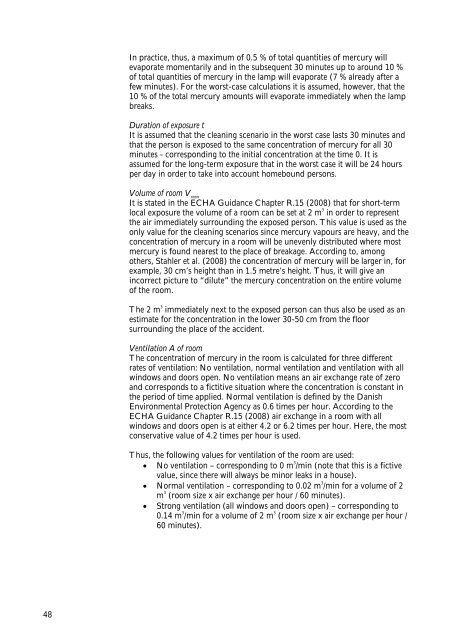No. 104 - Miljøstyrelsen
No. 104 - Miljøstyrelsen
No. 104 - Miljøstyrelsen
Create successful ePaper yourself
Turn your PDF publications into a flip-book with our unique Google optimized e-Paper software.
48<br />
In practice, thus, a maximum of 0.5 % of total quantities of mercury will<br />
evaporate momentarily and in the subsequent 30 minutes up to around 10 %<br />
of total quantities of mercury in the lamp will evaporate (7 % already after a<br />
few minutes). For the worst-case calculations it is assumed, however, that the<br />
10 % of the total mercury amounts will evaporate immediately when the lamp<br />
breaks.<br />
Duration of exposure t<br />
It is assumed that the cleaning scenario in the worst case lasts 30 minutes and<br />
that the person is exposed to the same concentration of mercury for all 30<br />
minutes - corresponding to the initial concentration at the time 0. It is<br />
assumed for the long-term exposure that in the worst case it will be 24 hours<br />
per day in order to take into account homebound persons.<br />
Volume of room Vroom It is stated in the ECHA Guidance Chapter R.15 (2008) that for short-term<br />
local exposure the volume of a room can be set at 2 m 3<br />
in order to represent<br />
the air immediately surrounding the exposed person. This value is used as the<br />
only value for the cleaning scenarios since mercury vapours are heavy, and the<br />
concentration of mercury in a room will be unevenly distributed where most<br />
mercury is found nearest to the place of breakage. According to, among<br />
others, Stahler et al. (2008) the concentration of mercury will be larger in, for<br />
example, 30 cm’s height than in 1.5 metre’s height. Thus, it will give an<br />
incorrect picture to “dilute” the mercury concentration on the entire volume<br />
of the room.<br />
The 2 m 3 immediately next to the exposed person can thus also be used as an<br />
estimate for the concentration in the lower 30-50 cm from the floor<br />
surrounding the place of the accident.<br />
Ventilation A of room<br />
The concentration of mercury in the room is calculated for three different<br />
rates of ventilation: <strong>No</strong> ventilation, normal ventilation and ventilation with all<br />
windows and doors open. <strong>No</strong> ventilation means an air exchange rate of zero<br />
and corresponds to a fictitive situation where the concentration is constant in<br />
the period of time applied. <strong>No</strong>rmal ventilation is defined by the Danish<br />
Environmental Protection Agency as 0.6 times per hour. According to the<br />
ECHA Guidance Chapter R.15 (2008) air exchange in a room with all<br />
windows and doors open is at either 4.2 or 6.2 times per hour. Here, the most<br />
conservative value of 4.2 times per hour is used.<br />
Thus, the following values for ventilation of the room are used:<br />
� <strong>No</strong> ventilation – corresponding to 0 m 3<br />
/min (note that this is a fictive<br />
value, since there will always be minor leaks in a house).<br />
� <strong>No</strong>rmal ventilation – corresponding to 0.02 m 3 /min for a volume of 2<br />
m 3<br />
(room size x air exchange per hour / 60 minutes).<br />
� Strong ventilation (all windows and doors open) – corresponding to<br />
0.14 m 3 /min for a volume of 2 m 3 (room size x air exchange per hour /<br />
60 minutes).

















